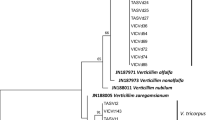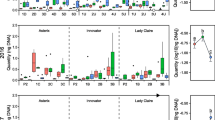Abstract
Samples of potato tubers from commercial seed stocks and from grower’s own seed in Turkey were received from 2011 through 2014. Six potato cultivars were involved: Agria (2011–2014); Marabel (2011–2014); Marfona (2012–2014); Hermes (2012–2014); Jelly (2013–2014); and Lady Olympia (2013–2014). Fifty tubers from each sample were examined macroscopically for fungal diseases. Eyes were excised from a 25-tuber subsample and were incubated and examined for pathogenic fungi. Twenty-five tubers were stored on trays to sprout and were examined for diseases and sprouting in May. Finally, in most years, samples of 25 tubers were wounded by dropping them onto expanded metal, after which they were stored at 5 °C and examined for dry rot after 12 weeks. Amounts of disease varied between years; during the 4 years, black scurf and powdery scab on Agria tended to increase, while black dot and late blight decreased. On average, 39% of Agria tubers were affected with black dot, 21% with black scurf and 10% with powdery scab. Dry rot affected 4% of tubers, and 91% of the isolates from rot were identified as Fusarium sambucinum Fuckel. Wounding tubers increased the incidence of dry rot threefold. During 2011–2012, late blight affected 3% of Agria tubers but fewer in later years and in other cultivars. Marabel had the most common scab (14% tubers), and Jelly had the most dry rot (7% tubers); this disease was increased by wounding the tubers. Conidiophores of Helminthosporium solani (silver scurf) were more common on excised eyes of Marfona, Lady Olympia and Jelly than those of other cultivars, and isolated verticillate conidiophores that developed on the side of incubated eye plugs of Agria and Marabel stocks yielded pure cultures of Verticillium dahliae (93%). The proportions of tubers with different diseases were affected by their regions of origin; Central Anatolia seed had the most black dot and dry rot, Western Black Sea seed had the most powdery scab, and late blight and Aegean seed had the most common scab and silver scurf. The epidemiology and management of these diseases has been studied extensively in the UK and Europe but not in Turkey. This study has highlighted the need for basic information on the epidemiology of these diseases in the soils and climates of Turkish potato growing areas and for the need to develop disease control strategies, particularly for seed potatoes.

Similar content being viewed by others
References
Abu-El Samen, F. M., & Al-Bdour, N. M. (2011). Prevalence of fungal and fungus-like diseases on potato seed tubers imported from Europe to Jordan. EPPO Bulletin, 41, 445–452.
Anonymous. (2010). Varieties catalog. Variety Registration and Seed Certification Center, Ministry of Food, Agriculture and Livestock, Data Dissemination Div. Publication no. 1215.
Anonymous. (2011). The summary of agricultural statistics. State Institute of Statistics, Prime Ministry of Republic of Turkey, Data Dissemination Div. Publication no. 3878.
Anonymous. (2013). Agricultural sector report. The Union of Chambers and Commodity Exchanges of Turkey, Data Dissemination Div. Publication no. 2014/230.
Anonymous. (2014). Turkey in statistics. State Institute of Statistics, Prime Ministry of Republic of Turkey, Data Dissemination Div. Publication no. 4380.
Cullen, D. W., Lees, A. K., Toth, I. K., & Duncan, J. M. (2001). Conventional PCR and real-time quantitative PCR detection of Helminthosporium solani in soil and on potato tubers. European Journal of Plant Pathology, 107, 387–398.
Denner, F. D. N., Millard, C. P., & Wehner, F. C. (1998). The effect of seed and soil borne inoculum of Colletotrichum coccodes on the incidence of black dot on potatoes. Potato Research, 41, 51–56.
Dhingra, O. D., & Sinclair, J. B. (1995). Basic plant pathology methods (2nd ed.). London (GB): Lewis Publishers.
Dugan, F. M. (2006). The identification of fungi, an illustrated introduction with keys, glossary, and guide to literature. St Paul, MN: American Phytopathological Society.
Geary, B., & Johnson, D. A. (2006). Relationship between silver scurf levels on seed and progeny tubers from successive generations of potato seed. American Journal of Potato Research, 83, 447–453.
Glais-Varlet, I., Bouchek-Mechiche, K., & Andrivon, D. (2004). Growth in vitro and infectivity of Colletotrichum coccodes on potato tubers at different temperatures. Plant Pathology, 53, 398–404.
Gore, M. E., Coşge Şenkal, B., Kuru Berk, S., Onaran, H., Altın, N., Ay, E., et al. (2015). Recovery of Verticillium dahliae from commercially available potato seed lots planted in Turkey and characterization of isolates by vegetative compatibility and aggressiveness. Phytoparasitica, 43, 241–251.
Hide, G. A. (1986). Some problems in the chemical control of potato tuber diseases. Aspects of Applied Biology, 13, 263–272.
Hide, G. A., Griffith, R. L., & Adams, M. J. (1977). Methods of measuring the prevalence of Phoma exigua on potatoes and in soil. Annals of Applied Biology, 87, 7–15.
Johnson, D. A., & Cummings, T. F. (2015). Effect of powdery scab root galls on yield of potato. Plant Disease, 99, 1396–1403.
Mattupalli, C., Genger, R. K., & Charkowski, A. O. (2013). Evaluating Incidence of Helminthosporium solani and Colletotrichum coccodes on asymptomatic organic potatoes and screening potato lines for resistance to silver scurf. American Journal of Potato Research, 90, 369–377.
Merz, U. (1997). Microscopical observation of the primary zoospores of Spongospora subterranea f. sp. subterranea. Plant Pathology, 46, 670–674.
Nitzan, N., Cummings, T. F., & Johnson, D. A. (2005). Effect of seed-tuber generation, soilborne inoculum, and azoxystrobin application on development of potato black dot caused by Colletotrichum coccodes. Plant Disease, 89, 1181–1185.
Read, P. J., Storey, R. M. J., & Hudson, D. R. (1995). A survey of black dot and other fungal tuber blemishing diseases in British potato crops at harvest. Annals of Applied Biology, 126, 249–258.
Rodriguez, D. A., Secor, G. A., Gudmestad, N. C., & Francl, L. J. (1996). Sporulation of Helminthosporium solani and infection of potato tubers in seed and commercial storages. Plant Disease, 80, 1063–1070.
Sadfi, N., Chérif, M., Hajlaoui, M. R., & Boudabbous, A. (2002). Biological control of the potato tubers dry rot caused by Fusarium roseum var. sambucinum under greenhouse, field and storage conditions using Bacillus spp. Isolates. Journal of Phytopathology, 150, 640–648.
Sensoy, S., Demircan, M., Ulupınar, Y. (2016). Climate of Turkey. Turkish State Meteorological Service, Data Dissemination Div. Publication, Ankara, Turkey. http://www.mgm.gov.tr/files/en-us/climateofturkey.pdf.
Sylvain, L., Anne-Marie, S. B., & Carole, B. (2009). Genetic and physiological determinants of Streptomyces scabies pathogenicity. Molecular Plant Pathology, 10, 579–585.
Tsror (Lahkim), L., Aharon, M., & Erlich, O. (1999). Survey of bacterial and fungal seed-borne diseases in imported and domestic potato seed tubers. Phytoparasitica, 27(3), 1–12.
Tsror (Lahkim), L., Erlich, O., & Hazanovsky, M. (1999). Effect of Colletotrichum coccodes on potato yield, tuber quality, and stem colonization during spring and autumn. Plant Disease, 83, 561–565.
Tsror (Lahkim), L., & Peretz-Alon, I. (2004). Control of silver scurf on potato by dusting or spraying seed tubers with fungicides before planting. American Journal of Potato Research, 81, 291–294.
Tsror (Lahkim), L., & Peretz-Alon, I. (2005). The influence of the inoculum source of Rhizoctonia solani on development of black scurf on potato. Phytopathology, 153, 240–244.
Tuncer, G. (1997). The incidence, distribution and control measurements of fungal diseases at stored potato tubers in Central Anatolia. The Ministry of Agriculture and Rural Affairs of Turkey, BKA/0 l-E-053.
Tuncer, G. (2002). The effect of irrigation and nitrogen on powdery scab and yield of potatoes. Potato Research, 45, 153–161.
Unlu, K., Ozenirler, G., & Yurteri, C. (1999). Nitrogen fertilizer leaching from cropped and irrigated sandy soil in Central Turkey. European Journal of Soil Science, 50, 609–620.
Woodhall, J. W., Lees, A. K., Edwards, S. G., & Jenkinson, P. (2007). Characterization of Rhizoctonia solani from potato in Great Britain. Plant Pathology, 56, 286–295.
Zhang, X. Y., Huo, H. L., Xi, X. M., Liu, L. L., Yu, Z., & Hao, J. J. (2016). Histological observation of potato in response to Rhizoctonia solani infection. European Journal of Plant Pathology, 145, 289–303.
Acknowledgements
This work was supported by the Turkish Potato Growers Organization. We express our thanks to Mr. Adnan Özkan for technical assistance.
Author information
Authors and Affiliations
Corresponding author
Rights and permissions
About this article
Cite this article
Göre, M.E. Fungal seedborne pathogens infecting potato seed tubers from Turkey, 2011–2014. J Plant Dis Prot 124, 539–551 (2017). https://doi.org/10.1007/s41348-017-0091-y
Received:
Accepted:
Published:
Issue Date:
DOI: https://doi.org/10.1007/s41348-017-0091-y




